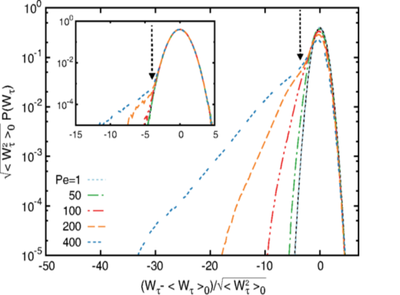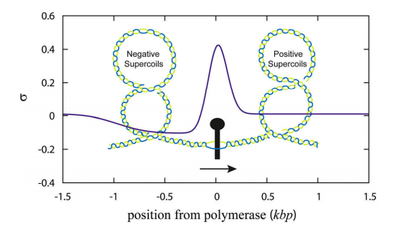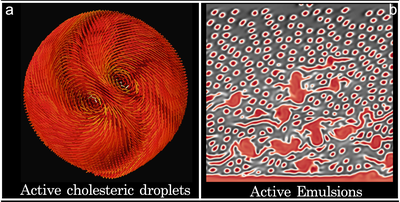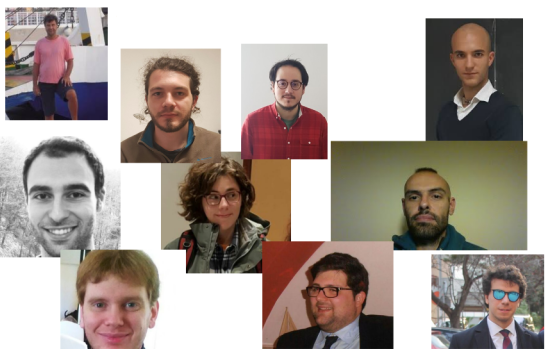Attività di Ricerca
In our research group, we confront challenging theoretical and computational problems in the field of statistical mechanics and condensed matter physics. Our current research is in the following areas:
1. Non-equilibrium Statistical Mechanics

Statistical mechanics started for giving a microscopic explanation of the thermodynamic description of the macroscopic world, bridging the two worlds. While equilibrium systems are well understood in this context, extending the statistical mechanical approach to the study of systems non in thermal equilibrium is a challenge very far from being deeply understood. In our research activity, we study general laws characterizing fluctuation distributions in non-equilibrium systems, and the possibility to extend traditional concepts like temperature or pressure to new contexts offered by biological systems or active matter, which are intrinsically out-of-equilibrium. An example of our results is the proof of a dynamical phase transition (in mathematical language, singular large deviation function) for the distribution of the work done by different systems of Brownian particle (Cagnetta et al., 2017, Semeraro et al. 2021, 2023, Carollo et al. 2023). Recently we also posed our attention on different problems, ranging from anomalous diffusion of single particles to the kinetics of nonequilibrium ferromagnetic models inspired by disordered systems theory (Carollo et al. 2023).
2. Active Matter
 Active matter is a new branch of soft condensed matter physics that poses remarkable challenges for the setting of proper non-equilibrium theoretical description and for the applications, especially in the field of drug delivery and in the design of biomaterials. The name refers to the fact that individual constituents of active systems are active, in the sense that they can convert energy into mechanical work or self-propulsion and, as a consequence, active matter systems are intrinsically always out of equilibrium. Examples are bacteria, artificial self-propelled colloids, suspensions of biological filaments like microtubules or actomyosin. In our group, we use the ideas of statistical mechanics to understand how, starting from simple physical rules for individual interactions, collective phenomena can emerge (Caporusso et al., PRL 2020, 2023, Soft Matter 2024). In the picture there is an example of a cluster of active colloids that show aggregation even in absence of any attractive force, with different colours denoting different orientational order.
Active matter is a new branch of soft condensed matter physics that poses remarkable challenges for the setting of proper non-equilibrium theoretical description and for the applications, especially in the field of drug delivery and in the design of biomaterials. The name refers to the fact that individual constituents of active systems are active, in the sense that they can convert energy into mechanical work or self-propulsion and, as a consequence, active matter systems are intrinsically always out of equilibrium. Examples are bacteria, artificial self-propelled colloids, suspensions of biological filaments like microtubules or actomyosin. In our group, we use the ideas of statistical mechanics to understand how, starting from simple physical rules for individual interactions, collective phenomena can emerge (Caporusso et al., PRL 2020, 2023, Soft Matter 2024). In the picture there is an example of a cluster of active colloids that show aggregation even in absence of any attractive force, with different colours denoting different orientational order.
3. Complex fluids and Soft Matter
During years, we have developed theoretical and numerical methods to model several kinds of complex fluids where internal structures like interfaces or droplets play a relevant role in dynamical and flow properties. The two pictures on the side refer to the case of active fluids where a large collection of active long molecules or filaments (in panel (a) a droplet of microtubules-kinesin bundles with chiral dopant) exert a stress on the local fluid enviroment generating a dipolar flow field. By using lattice Boltzmann methods we showed in PNAS 2019, Carenza, Negro, Gonnella e Marenduzzo that the droplet of panel (a) has a surprisingly rich range of dynamical macroscopical behaviours ranging from spontaneous rotations to screw-like unidirectional motion. The phenomena that we uncover are linked to the non-trivial topology of the defects, related to the Poincaré-Hopf theorem, that form by necessity at the droplet surface. Figure in panel (b) is related to another challenging topic in active matter concerning mutual interaction of active droplets suspended in a fluidic background. The figure shows a configuration of an emulsion of active droplets (red) dispersed in a Newtonian background (black). When confined between moving walls this system shows many peculiar rheological properties (Soft matter 2019, Negro, Carenza, Gonnella, TIribocchi, Lamura) such as for example superfluidic (or zero effective viscosity) behavior.
4. Modelling biological systems

We have also used a statistical physics approach for modelling biological systems where randomness plays a fundamental role. An example is given in this picture (see Physical Review Letters 2017, Bentivoglio, Gonnella et al ) with a cartoon of the DNA double helix and RNA polymerase during a transcription process. We showed that the supercoiling excess induced by the presence of the polymerase is responsible for the transcription bursts experimentally observed. Another problem in which we are now involved concerns the study of the three-dimensional conformation adopted by the human chromosomes in nuclear space. This is an important focus in genome biology, as they underlie gene activity in health, ageing and disease. We aim to characterize such conformations with a minimal model with proteins of several types (transcription factors) that bind selectively in specific regions of the chromatin (represented by a polymer) and cause the formation of molecular bridges stabilizing loops and spontaneous clusterization of proteins of the same type.
The research group

